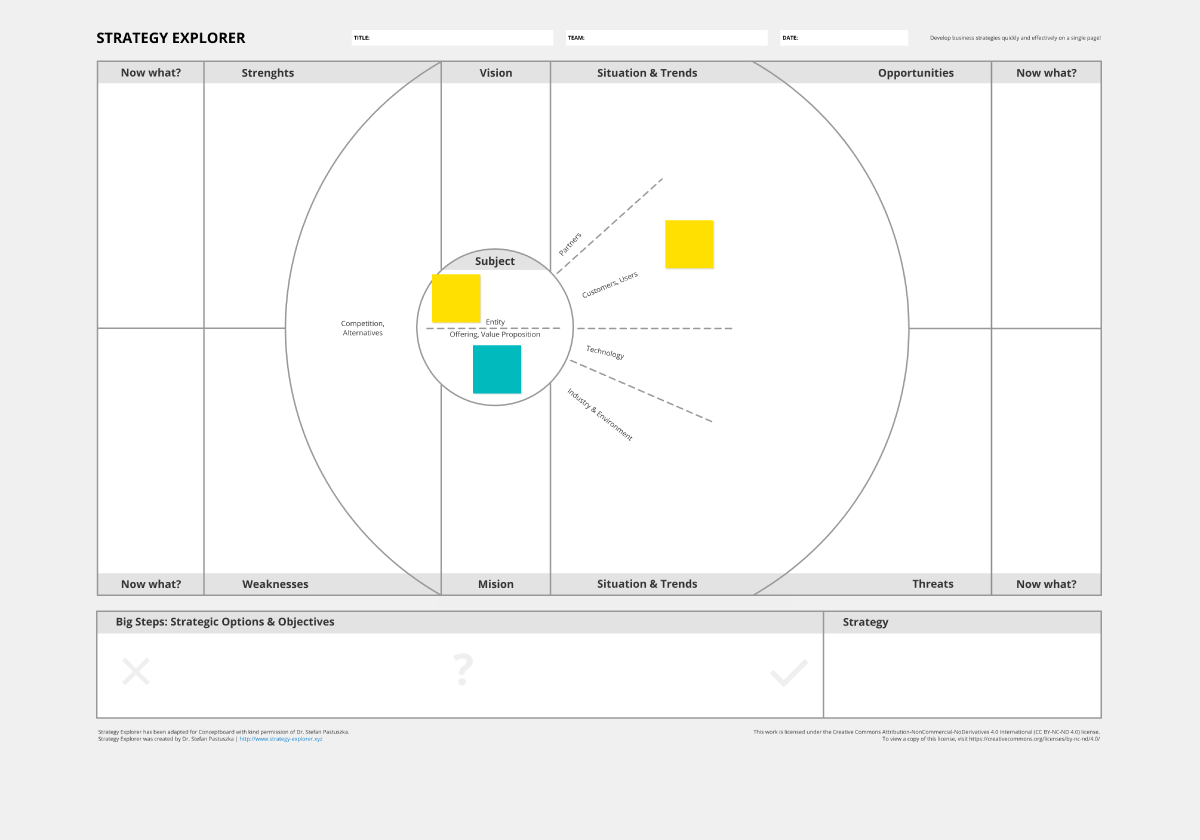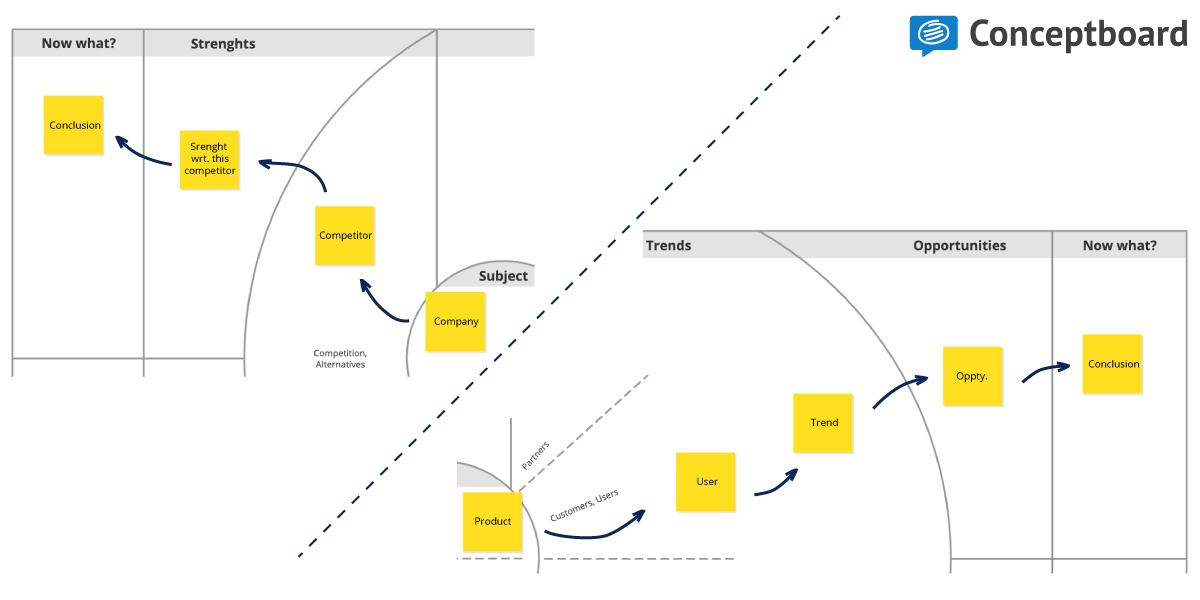The Strategy Explorer Canvas: Strategy development on a single page
You can generate a prototype version of your strategy in only a few hours when working alone or in a one day workshop with your team. Instead of spending a full day online, which could be tough, you can easily slice the workshop according to the three phases and re-energize or complete some research in between.

If you want to enable your team to develop strategies in a swift and agile fashion, the Strategy Explorer is the weapon of choice to get the task done. It is a canvas-based method that helps you create strategies for a wide range of subjects on a single page. It’s quick and intuitive compared to other more complex and lengthy processes.
In physical workshop situations, the template is printed in poster format, stuck on the wall and worked on using Post-It notes. In the virtual space, you can strategize just as effectively by using the Strategy Explorer template in Conceptboard – an online collaborative whiteboard. In this article, we’ll show you how to get started with a Strategy Explorer session. Plus, there are links to bonus articles under each section if you want to go deeper, or have a look at my book to learn more.

When should I use the Strategy Explorer?
The Strategy Explorer is the perfect tool for the following situations:
- You have goals that are in conflict with those of other entities or will harm them (like becoming a market leader, winning the best employees, launching a more environmentally friendly product, etc.)
- The subject at the centre of your considerations (company, department, person, product etc.) depends on customers who have alternatives.
- The success of your strategy depends to a certain extent on external factors which are out of your control.
In business-related matters, at least one of these conditions will certainly apply.
How does the Strategy Explorer work?
The Strategy Explorer guides you through the development of your strategy in three phases, as shown in the graphic:

- Subject, Vision and mission– Why, for what and to which end do we develop a strategy?
- Environment & SWOT-What is the situation and what are we going to do about it?
- Big Steps & Strategy – Which major steps will bring us to the goal?
Essentially, you start laying the foundations in the center of the Strategy Explorer, then work outwards to analyze the situation and its potential developments, collect ideas and draw initial conclusions. Then you work downwards to prioritize and consolidate your findings and finally devise the most promising strategy. The process consists of six key steps:
1. Title and Subject:Why do you want to develop a strategy? Find a concise title for what your strategy development is about. For what do you want to develop a strategy? This is the subject, which is defined by two aspects:
- the physical entity (= company, department, person, product, etc.) and
- its offering (= product, service, etc.) or value proposition (= problem-solving, satisfying needs, etc.) towards its customers or users.
The precise definition of the subject determines its competitors, so you need to be very clear here. [Learn more]
2. Vision and Mission: Both are crucial for strategy development, as they will guide your thinking and have a big impact on the result:
- The mission describes the purpose of your subject, i.e., the reason why it exists.
- The vision is a picture of the future from today’s perspective that includes the big goals you want to accomplish. Capture these in the vision field of the Strategy Explorer. [Learn more]
3. Situation & Trends: Almost every possible subject is governed by external factors which are out of its control – especially in business. Therefore, it is important to understand the environment and the relevant influencing factors. Capture relevant observations regarding the current situation and expected developments and trends in the big circle:
- To the left: competitors and alternatives.
- To the right: partners, customers and users, technology, industry and the larger environment.
Tip: place sticky notes with observations regarding the current situation closer to the centre, while placing future developments more to the outside of the circular field – this will later help you create logical chains! [Learn more]
4. SWOT – Now what? Which relevant strengths (S), weaknesses (W), opportunities (O) and threats (T) can you derive from the analysis of the environment? Use our free SWOT template here.
- S, W: compare the subject with its competitors or the alternatives to its offering.
- O, T: derive these from the situation and its potential development.
For each of your observations, ask yourself “Now what?”, i.e., how are you going to deal with them (how to exploit the opportunities, use the strengths, reduce the weaknesses and ameliorate the threats)? These insights will form a large part of the input for the next step. In your work, try to build logical chains, as shown in the graphic. [Learn more]

5. Big Steps: What are the crucial steps towards the vision? Insight comes from the answers to the “Now what?” questions, and also directly from asking “what should we really do to achieve our vision?” Formulate qualitative objectives and place them in this field. Then, do a prioritization according to three categories:
- Right-hand side: yes, should be done! (✓)
- Middle: maybe, or not now… (?)
- Left-hand side: no, rather not. (X) [Learn more]
6. Strategy: Not everything that has been considered in the previous step should necessarily be put into practice. Rather, the available options must be assessed, and the most suitable ones be used to construct the most promising strategy. Capture the few most important steps in the Strategy field. The formulation of a concise strategy sentence helps to gain clarity about the future direction and is an ideal basis for all further activities: “we will reach our vision (= ?) by doing XYZ (= major steps).” [Learn more]
By following this process with the Strategy Explorer, you will develop a complete strategic picture with transparent and visible logical chains from observations to conclusions, instead of piece by piece when using disconnected individual tools.
You can generate a prototype version of your strategy in only a few hours when working alone or in a one day workshop with your team. Instead of spending a full day online, which could be tough, you can easily slice the workshop according to the three phases and re-energize or complete some research in between.
So go for it! I wish you every success in developing your strategy with the Strategy Explorer!
Additional Resources
- PDF with guiding questions.
- The book (“Strategy Explorer – das Strategiewerkzeug für Teams”, in German).
- Strategy Explorer printable template for physical workshops.
- Have a look at other strategy-based templates such as the Business Model Canvas and the Lean Canvas
Contact me on LinkedIn.

